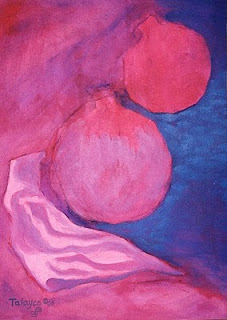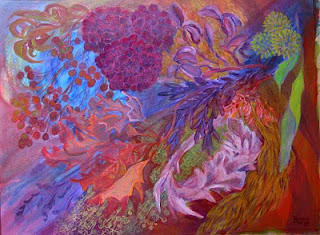
Almost every painting I've made has something edible in it -- if not edible by humans, as in "Pomegranate Float" (2005) above, then by insects as in "Dreams of Wild Botanists (Warm)" (2005):--

This sort of Edible Art is one thing, and here's another described in a 2010 article in American Artist magazine on the general theme of (Buzz Word Alert!) "green" artists' materials.
Glob (http://www.globiton.com/) in Berkeley, California, touts the fact that its six paints (lemon verbena, tangerine, plum purple, berry blue, pomegranate, and basil green) are made from fruits, vegetables, flowers and spices, and are biodegradable, non-toxic, gluten-free, soy-free and vegan.
Following the link to Glob -- as I thought fondly of my youngest and newest friend, a specialist in gluten-free delectables (hi, JV!) -- I discovered they're serious about "environmental synergy" and apparently market to children who, if not already fond of eating their art materials, will soon develop the habit.
Well, they're following in historical footsteps, it seems. Writing of colourmen (early European producers and purveyors of artists' pigments), Victoria Finlay (mentioned in my previous post) reports:
Colourmen first appeared in the mid-17th century, preparing canvases, supplying pigments, and making brushes. In France, some of them were originally luxury goods grocers, selling exotica like chocolate and vanilla, along with the cochineal (a sought after red pigment derived from insects -kt), but most quickly turned to full-time art supplying.
In my years of painting, two lessons on edibility have stayed with me: (1) Inside the studio, food and drink should not be consumed in order to avoid the risk of possible contamination with toxic substances; (2) Outside the studio, chocolate is always in good taste.


Happy new year Kelly! This post took me all the way back to primary school where I sat next to a boy called Scott who ate Clag glue and rubber shavings. Eek.
ReplyDeleteHere, here!
ReplyDelete